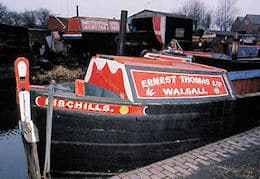Joey boats — day boat work-horses of the Birmingham canals
At the geographical centre of the English waterway network is a tight knot of narrow canals, built largely to carry coal from the local mines to the manufacturing industries of Birmingham and the Black Country, whose appetite for fuel was voracious throughout the canal age.
These canals, eventually amalgamated as the Birmingham Canal Navigations, developed a style of craft all of their own — slab sided square sectioned open boats with a straight stem and stern, strongly built for maximum capacity but with a minimum of fancy frills. They were generally double ended so that the rudder could be hung on either end to avoid the need for turning them round in congested loading basins. Although they were certainly ‘narrow boats’ in the strict measurement sense, these BCN boats were treated very differently to the graceful long distance cabin boats with their lace curtains, painted castles and house proud crews.
In this Midland area the boatman and his mate could deliver a loaded boat to the factory wharf, immediately transfer the rudder, towing mast and all their essential boating tools on to an empty boat and set off back to the colliery to reload. There was not, therefore, any personal involvement with any one boat. Distances were relatively short and most journeys would be completed in a day (although they were very long days…) so the crews would generally get to spend most nights back at home, in a house. If there were cabins on these boats they were small and sparsely furnished and not designed to be lived in, although the boatmen would spend a night or two on board when necessary.
These horse drawn day boats or ‘joey-boats’ as they were rather disdainfully called, were fantastically important to the canal industry of the Midlands, and it is a sad fact that only a tiny proportion of the thousands that were still at work in the 1950s now exist at all. There are a number of iron and steel boats still in commission but the more common wooden ones have nearly all vanished. There is only one single wooden joey boat afloat (usually) in anything like carrying condition, the Birchills on display at the Black Country Museum in Dudley.
BCN Tugs
 As elsewhere on the canal system, the horse was the prime motive power for most of the BCN joey boats’ history, and a few animals were working commercially until the end of regular coal carrying in the 1960s. However, because a very large proportion of the BCN network was built on two main levels, separated by just three locks, it was far more practical and economic to pull trains of boats with a single tug here than elsewhere on the system.
As elsewhere on the canal system, the horse was the prime motive power for most of the BCN joey boats’ history, and a few animals were working commercially until the end of regular coal carrying in the 1960s. However, because a very large proportion of the BCN network was built on two main levels, separated by just three locks, it was far more practical and economic to pull trains of boats with a single tug here than elsewhere on the system.
When reliable diesel engines became available in the early twentieth century many small canal tugs were built especially for this traffic, powerful enough to pull three or four loaded boats into Wolverhampton and Birmingham, or a whole chain of empty ones back to the pits. This development helped to keep the canals competitive against other forms of transport until industry generally changed from coal to other forms of fuel.
Many, perhaps even most of those tugs are still to be seen all over the canal system for although heavily ballasted to keep their big propellers deep in the water, they have proved to be perfect pleasure boats for the committed canal enthusiast. In fact they now provide the model for many of the newest private holiday boats that seek to emulate the subtle grace of these chunky old workboats.
‘Hampton boats.
Wolverhampton and much of the Black Country was linked to the Cannock Chase coal mining area by a single level of canal, without locks, and for this route a number of bigger boats were developed to increase the payload to the maximum. Their size was only constrained by the width of the bridges and the maximum length of boat that could be manoeuvred round Horsely Fields junction in Wolverhampton. In practice this meant a boat about 85 feet long by 8 foot 6 inches beam and a number of these wooden ‘’Ampton boats’ were worked behind tugs on the power station traffic in to the 1960s. But because they couldn’t go anywhere else when they finished work they are now only a canal memory.
All materials and images © Canal Junction Ltd. Dalton House, 35 Chester St, Wrexham LL13 8AH. No unauthorised reproduction.
About | Terms | Privacy| Refunds & Returns| Sitemap | Contact Us
With over 800 pages, this website uses cookies to record visitor behaviour using Google Analytics. More information on Privacy Page. Page last updated: 02/05/2025.




Back to Menu....
Narrowboats & Barges >>
Canal Heritage >>